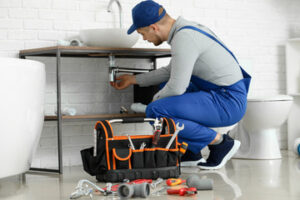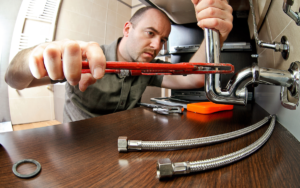Plumbing is the network of pipes, fixtures, and other components that deliver water and remove waste in a home or business. It’s important to understand how plumbing works so that you can make smart decisions about maintenance and repairs.

The two subsystems of your home’s plumbing are the water supply system and the drainage system. The former provides clean water, while the latter gets rid of wastewater. Contact Plumbing Express, Inc. for professional help.
Baking soda and vinegar are household products that create a chemical reaction when they mix. This reaction can break up and dissolve clogs in drains and eliminate odors. It is also a natural and safe alternative to commercial drain cleaners. However, it is important to understand how this cleaning method works before using it in your home.
The first step in using baking soda and vinegar is to empty the sink or bathtub of any obstructing debris. Then, run hot water down the drain for a minute. This will remove any grease or hair and loosen any debris. Next, pour a cup of baking soda down the drain. Follow the baking soda with a cup of white vinegar to start the chemical reaction.
This process can dislodge minor clogs and prevent them from returning. It is also an inexpensive alternative to chemical drain cleaners. However, this method is not as effective for stubborn clogs and may require professional intervention.
When the two chemicals combine, they create carbon dioxide gas. This gas can build up in your pipes and lead to cracks or leaks over time, especially in older homes with copper or brass plumbing. It can also cause damage to the seals in your drain trap.
To avoid this problem, use a different method for unclogging your drains. Pouring baking soda and vinegar into a clogged drain creates pressure that can push the clog down the pipe. However, the resulting pressure can also cause the baking soda and vinegar to back up into your home’s plumbing system.
The best way to use baking soda and vinegar is to pour the mixture down a dry drain. It is also helpful to saturate the baking soda with hot water before it enters the drain. The hot water will help to ensure that the entire mixture reaches the clog and creates a chemical reaction.
Table salt
Table salt is a household staple that can help clear minor drain clogs. It works by creating a thick foam that helps break down grease and gunk. It also dissolves quickly and is inexpensive. It can also be used as an alternative to expensive drain cleaners. However, if you have a serious clog, it is best to call a plumber for professional help.
Table salt contains sodium chloride (NaCl) and is made from either mined rock like halite or evaporated seawater. It is heavily processed to create a fine salt grain and contains additives to prevent clumping. It also has iodine added, which is important for maintaining a healthy thyroid.
Adding salt to a clogged drain can help break down grease and gunk, but it is not an effective way to clean the entire pipe. It can also damage PVC pipes and cause corrosion over time in older metal drains. However, it is still safe to use when combined with boiling water or baking soda.
In addition to sodium chloride, table salt contains many other minerals. Some of these minerals are essential for human health, while others may be toxic if consumed in large quantities. The concentration of these elements varies among different salts and can be influenced by the type of soil and rock from which they are harvested. Gourmet table salts tend to have lower levels of aluminum, nickel, and cobalt than budget-friendly brands. However, it is difficult to find salt with low concentrations of lead and mercury.
Bleach
Bleach is an incredibly useful household chemical that can be used for disinfecting surfaces, breaking down stains and neutralizing odors. It can also be poured down drains to clean and deodorize. However, bleach can have negative effects on drain and septic systems.
Bleaching has strong oxidizing properties, which can discolor and corrode pipes over time. It is also toxic to the environment. If it comes into contact with other chemicals, it can create dangerous fumes and may even react to form chlorinated volatile organic compounds (VOCs), which can contaminate the air.
It is important to note that bleach must be used in accordance with the manufacturer’s label instructions and should never be mixed with acidic cleaners, such as vinegar. When bleach is mixed with these substances, it can form chlorine gas, which can be hazardous to the lungs. Furthermore, it can also damage the p-trap, which is responsible for blocking sewer gases from entering the home.
Bleach can be used to clean and deodorize drains, but it cannot remove a clog. It is important to remember that a clogged drain can be caused by many factors, including a physical blockage or an improperly installed pipe. Therefore, it is best to contact a professional plumber for clog removal. Alternatively, you can try using a natural bacterium, like the kind found in the product Grease Away, which can digest grease and other organic materials that cause clogs. This bacterium can be purchased at Mr. Rooter and is recommended for use on kitchen drain lines. This product is safe for the environment and septic system, as it does not produce any toxic byproducts. However, it does require a longer period of time to work.
Boiling water
Boiling water is a natural drain cleaning solution that can be useful for certain types of clogs. It is effective for dissolving food particles, grease, and soap scum. It can also be helpful for loosening the clog and clearing it from the pipe. However, it is important to understand how boiling water interacts with different clog materials and conditions before using this method. This can help prevent damage to pipes and ensure safe, effective drain maintenance.
When water boils, its molecules transfer their thermal energy to the surrounding air, causing it to rise and expand. This process also known as vaporization, happens because the liquid’s molecular structure changes shape to form gas bubbles that escape into the air. The heat of the boiling water transfers this energy to the clog material, melting it or breaking it apart. It is important to note that this method does not work on solid objects like toys, sanitary products, or excess toilet paper. These clogs require physical removal and may be exacerbated by the boiling water if it has been used in conjunction with chemical drain cleaners.
Choosing the right pot or kettle is crucial for this hack, since it must be able to handle high temperatures. It is also recommended that you choose a spout that allows for controlled pouring to reduce the risk of splashing or spilling boiling water. If possible, use oven mitts or gloves to protect your hands from the heat. Finally, ensure that children and pets are not near the sink when handling boiling water to avoid accidents.
It is also important to know that this method is only suitable for PVC (Polyvinyl chloride) pipes, as the hot temperature of boiling water can damage or melt other types of piping. This is especially true for older homes with corroded metal plumbing, which can lead to structural damage and leaks.
Pipe brush
A pipe brush is a tool that removes rust, scale, and other debris from pipes. It can also deburr pipe ends before making connections. A tube cleaning brush can be made of steel, brass, or nylon bristles. Steel bristles are best for heavy-duty tasks, while brass and nylon can be used on softer materials.
A shank wire brush has a bundle of bristles attached to a long, slender metal stem or “shank.” This allows the brush to be inserted into narrow interiors of pipes and tubes. These brushes are ideal for cleaning areas that are hard to reach with a power tool such as a drill.
A pipe brush can be used to clean a drain that is full of cold water mold. This can help prevent clogged drains and unpleasant odors. The brush should be placed in the drain and rubbed against it with moderate pressure. A drain cleaner should be added to ensure that the build-up is completely removed. If the problem persists, it is important to seek professional inspection from a pipe inspector to evaluate whether the pipe can be reused.
